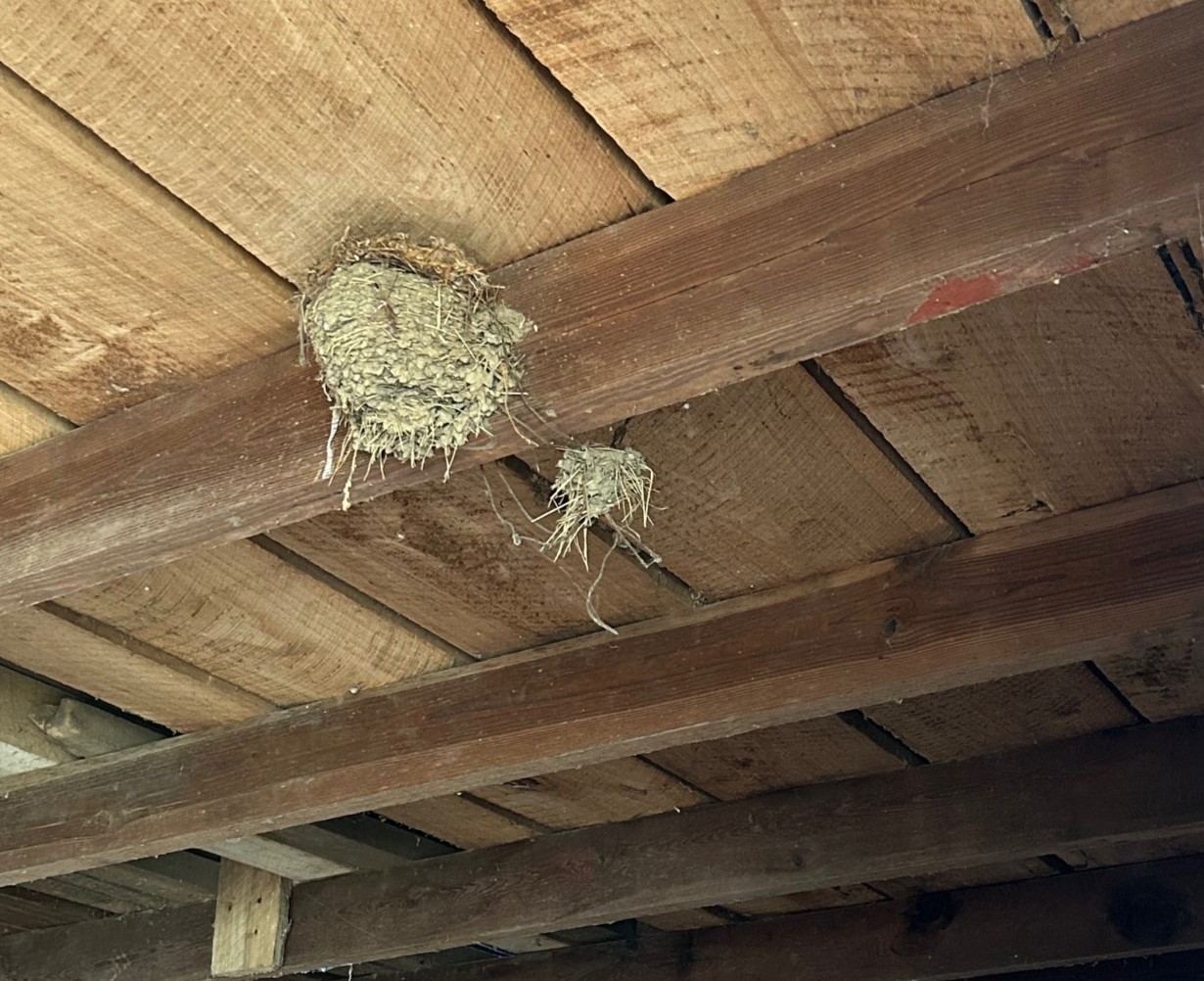We have an old shed on Owl Acres where we keep firewood and the Farmall “A” tractor that Bryan uses for mowing. Inside the shed, up against one of the beams, is a carefully constructed nest. It’s made of mud and straw and has one side plastered against the beam. The nest was built in the late spring by a pair of barn swallows (Hirundo rustica). The birds selected the shed as a safe place to build their nest and rear their young. Then, working together, they began to build. First, they collected pellets of mud from the yard and smashed them against the beam to form one side of the nest. The mud had to be the right consistency so it would stick to the wood. Then they built a shelf to sit on while they built up the sides of the nest. They added strands of straw and grass, working it in to stabilize the mud. After upwards of a thousand individual trips from the mud source to the nest with one pellet of mud at a time, the birds created a sturdy bowl with one side flattened against and sticking to the beam. The bottom of the bowl hangs below the beam, and is expanded to allow for eggs and nestlings. The inside of the nest is lined with feathers and grass. It’s a very cozy little pocket of softness and safety for the eggs and nestlings of these barn swallows.
Barn swallows are little, colorful songbirds, about six inches long with a wingspan of about 13 inches. Their backs and wings are a metallic blue-black. Underneath they are buff to white, and their throats and foreheads are a chestnut color. They have short bills, and their wings are long and narrow, tapering to a point at the tips. Their most notable feature is their long, forked tails. They have a particularly graceful, enchanting flight.
Barn swallows live on every continent even including Antarctica where one was spotted. The name “swallow” has nothing to do with ingesting food, although they do catch their prey on the wing. More likely, it comes from the Old Norse swala, which means a cleft stick and refers to their forked tails.
On a balmy September day, we watched an amazing ballet unfold in the front yard. Tiny midges were rising from the grass in swarms. Above them some 30 feet or so, a troupe of dragonflies swirled and darted, catching the midges. And above the dragonflies, much higher in the sky, a flock of barn swallows gracefully sailed and swooped, catching midges and dragonflies on the wing. Shortly thereafter, the barn swallows were gone, heading in daytime flocks along open fields, rivers and mountain ridges, always south. They wouldn’t rest until they reached South America, thousands of miles away. After their long migration south, the barn swallows will begin to grow new feathers and discard the old ones. The process of molting will take them much of the winter, one or two feathers at a time, and when they’re done, it will be time to go north again.

Dramatic shot of a barn swallow in flight, slightly above the camera, flying from right to left in the frame. Dark above and light grey below. Deeply forked tail, typical of swallows, is in trail position (not spread wide). Image emphasizes the wingspan of the bird, at more than double its body length. Photo from Wikimedia.org by Giles Laurent
Swallows have captured the imagination of cultures for thousands of years. Generally, they are considered positive. If a swallow chooses your place to nest, it means good fortune, and immunity from disease, curses and fire.
Another oft-reported legend is that the swallow flew to the heavens and stole fire from the gods. The gods were angry, and as the swallow fled, they sent a bolt of lightning that caught the middle feathers in the swallow’s tail, leaving all swallows’ tails permanently forked.
Sailors considered the swallow good luck. The tattoo of a swallow signified a long voyage successfully completed. If a sailor drowned, however, the swallows would pull his soul out of the water and send it to heaven.
Closer to home, 19th-century women were in an arms race to see who could have the most flamboyant or elegant hat. Feathers were popular as decorations, but why stop there? They perched actual stuffed birds on the hats. Barn swallows and their feathers with their beautiful metallic blue coloring were particularly prized, to the detriment of the swallow population. In 1886, George Bird Grinnell, the editor of Field and Stream Magazine, wrote a series of scathing editorials decrying the wanton slaughter of barn swallows in the name of fashion. This got people’s attention, and the barn swallows got a break. In 1905 Grinnell would go on to establish the Audubon Society for the protection of birds. In 1918, the Migratory Bird Act would be passed to protect migrating birds from wholesale destruction.
Barn swallows will repair and reuse a nest if it’s in pretty good shape, so we’ll leave this one alone and hope they’ll bring us luck again next summer.
Feature Photo by Author. Alt text: The mud and grass nest of a barn swallow sticks to the side of a joist in the shed.

1 comment